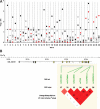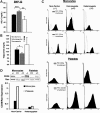Variants in the CD36 gene associate with the metabolic syndrome and high-density lipoprotein cholesterol
- PMID: 18305138
- PMCID: PMC2655228
- DOI: 10.1093/hmg/ddn060
Variants in the CD36 gene associate with the metabolic syndrome and high-density lipoprotein cholesterol
Abstract
A region along chromosome 7q was recently linked to components of the metabolic syndrome (MetS) in several genome-wide linkage studies. Within this region, the CD36 gene, which encodes a membrane receptor for long-chain fatty acids and lipoproteins, is a potentially important candidate. CD36 has been documented to play an important role in fatty acid metabolism in vivo and subsequently may be involved in the etiology of the MetS. The protein also impacts survival to malaria and the influence of natural selection has resulted in high CD36 genetic variability in populations of African descent. We evaluated 36 tag SNPs across CD36 in the HyperGen population sample of 2020 African-Americans for impact on the MetS and its quantitative traits. Five SNPs associated with increased odds for the MetS [P = 0.0027-0.03, odds ratio (OR) = 1.3-1.4]. Coding SNP, rs3211938, previously shown to influence malaria susceptibility, is documented to result in CD36 deficiency in a homozygous subject. This SNP conferred protection against the MetS (P = 0.0012, OR = 0.61, 95%CI: 0.46-0.82), increased high-density lipoprotein cholesterol, HDL-C (P = 0.00018) and decreased triglycerides (P = 0.0059). Fifteen additional SNPs associated with HDL-C (P = 0.0028-0.044). We conclude that CD36 variants may impact MetS pathophysiology and HDL metabolism, both predictors of the risk of heart disease and type 2 diabetes.
Figures



References
-
- Klein B.E., Klein R., Lee K.E. Components of the metabolic syndrome and risk of cardiovascular disease and diabetes in Beaver Dam. Diabetes Care. 2002;25:1790–1794. - PubMed
-
- Malik S., Wong N.D., Franklin S.S., Kamath T.V., L'Italien G.J., Pio J.R., Williams G.R. Impact of the metabolic syndrome on mortality from coronary heart disease, cardiovascular disease, and all causes in United States adults. Circulation. 2004;110:1245–1250. - PubMed
-
- Ford E.S., Giles W.H., Dietz W.H. Prevalence of the metabolic syndrome among US adults: findings from the third National Health and Nutrition Examination Survey. JAMA. 2002;287:356–359. - PubMed
-
- Tonkin R. The X factor: obesity and the metabolic syndrome in. The Science and Public Affairs Forum. 2003
-
- An P., Freedman B.I., Hanis C.L., Chen Y.D., Weder A.B., Schork N.J., Boerwinkle E., Province M.A., Hsiung C.A., Wu X., et al. Genome-wide linkage scans for fasting glucose, insulin, and insulin resistance in the National Heart, Lung, and Blood Institute Family Blood Pressure Program: evidence of linkages to chromosome 7q36 and 19q13 from meta-analysis. Diabetes. 2005;54:909–914. - PubMed
Publication types
MeSH terms
Substances
Grants and funding
- U10 HL054472/HL/NHLBI NIH HHS/United States
- U10 HL054497/HL/NHLBI NIH HHS/United States
- R01 DK060022/DK/NIDDK NIH HHS/United States
- R01 DK60022/DK/NIDDK NIH HHS/United States
- U10 HL54473/HL/NHLBI NIH HHS/United States
- P30 DK056341/DK/NIDDK NIH HHS/United States
- U10 HL54496/HL/NHLBI NIH HHS/United States
- U10 HL054473/HL/NHLBI NIH HHS/United States
- U10 HL54497/HL/NHLBI NIH HHS/United States
- DK56351/DK/NIDDK NIH HHS/United States
- U10 HL54471/HL/NHLBI NIH HHS/United States
- U10 HL054509/HL/NHLBI NIH HHS/United States
- R37 DK016746/DK/NIDDK NIH HHS/United States
- U10 HL54509/HL/NHLBI NIH HHS/United States
- U10 HL54495/HL/NHLBI NIH HHS/United States
- U10 HL54472/HL/NHLBI NIH HHS/United States
- U10 HL054515/HL/NHLBI NIH HHS/United States
- R01 DK033301/DK/NIDDK NIH HHS/United States
- U10 HL54515/HL/NHLBI NIH HHS/United States
- U10 HL054495/HL/NHLBI NIH HHS/United States
- U10 HL054496/HL/NHLBI NIH HHS/United States
- U10 HL054471/HL/NHLBI NIH HHS/United States
LinkOut - more resources
Full Text Sources
Other Literature Sources
Medical

